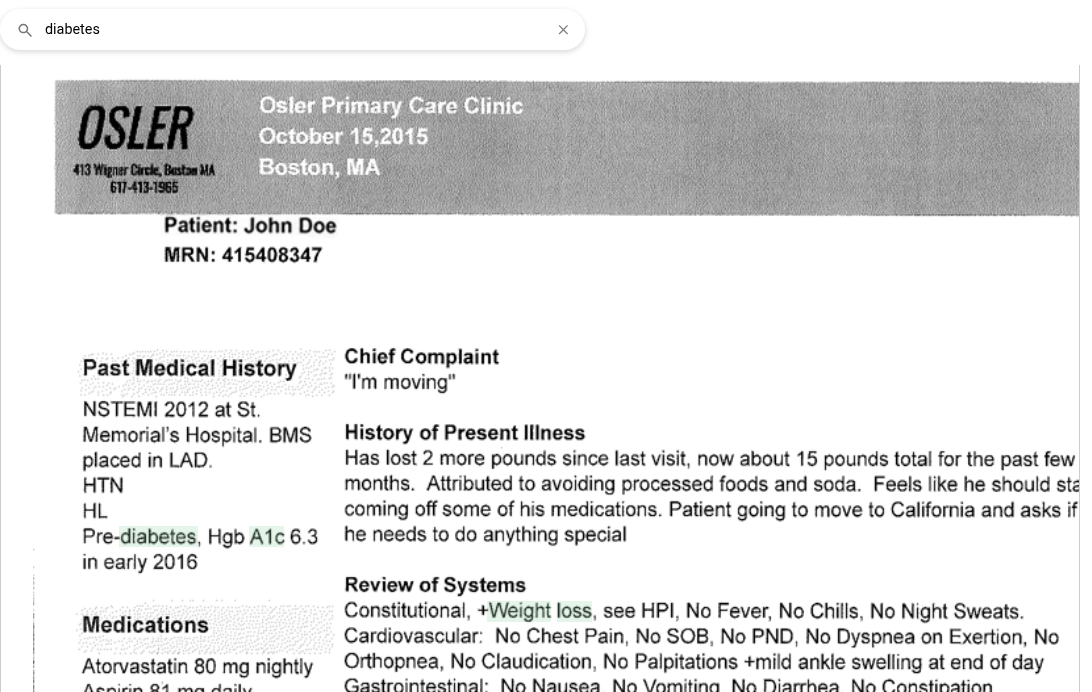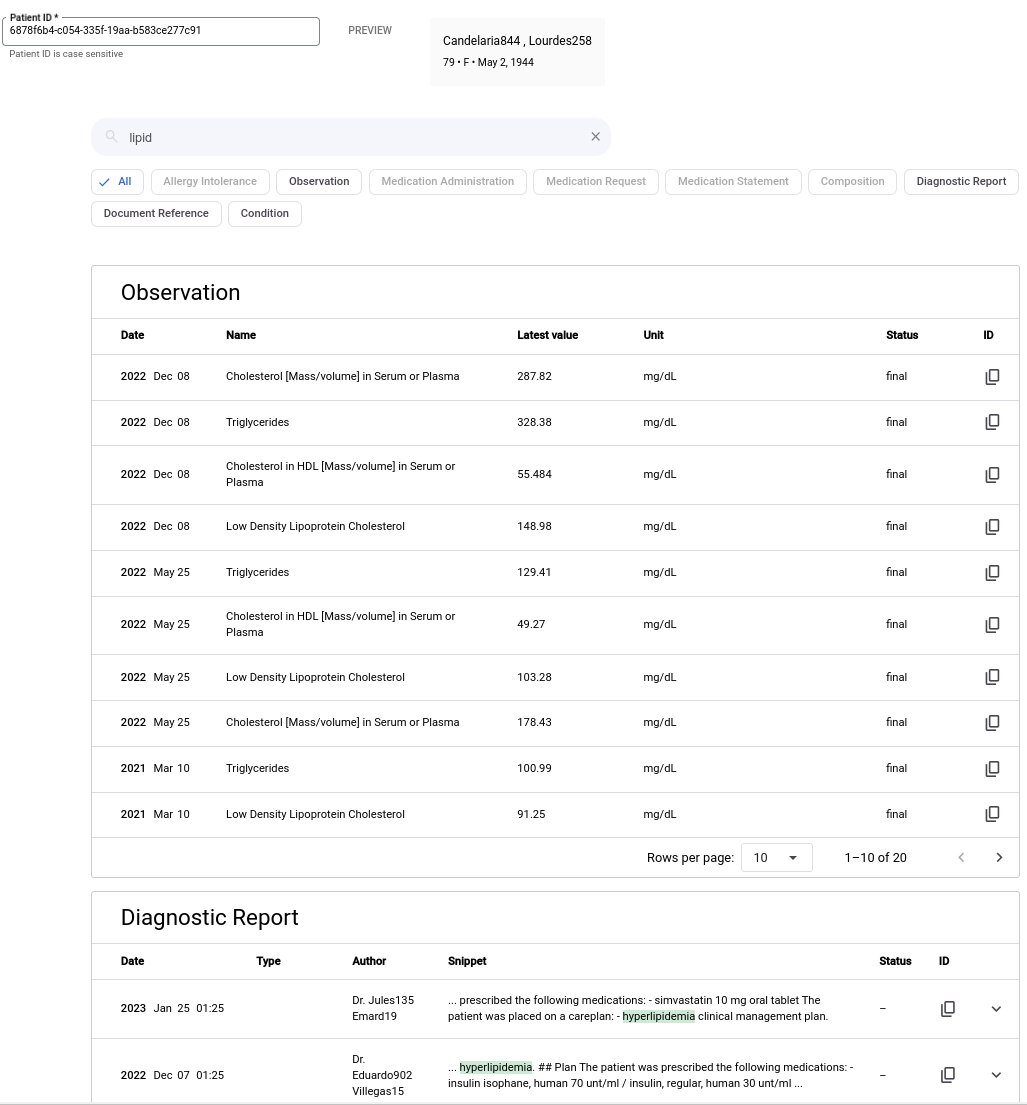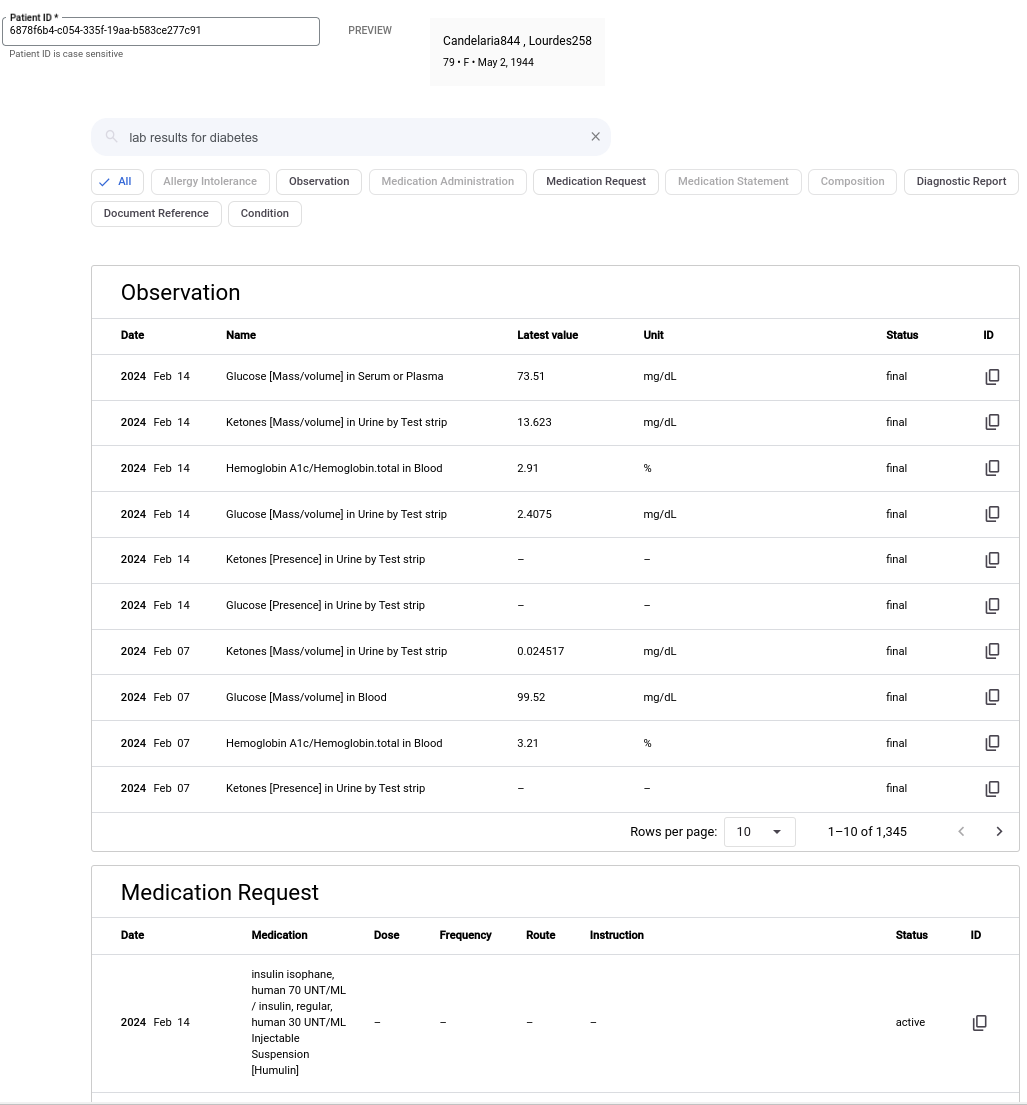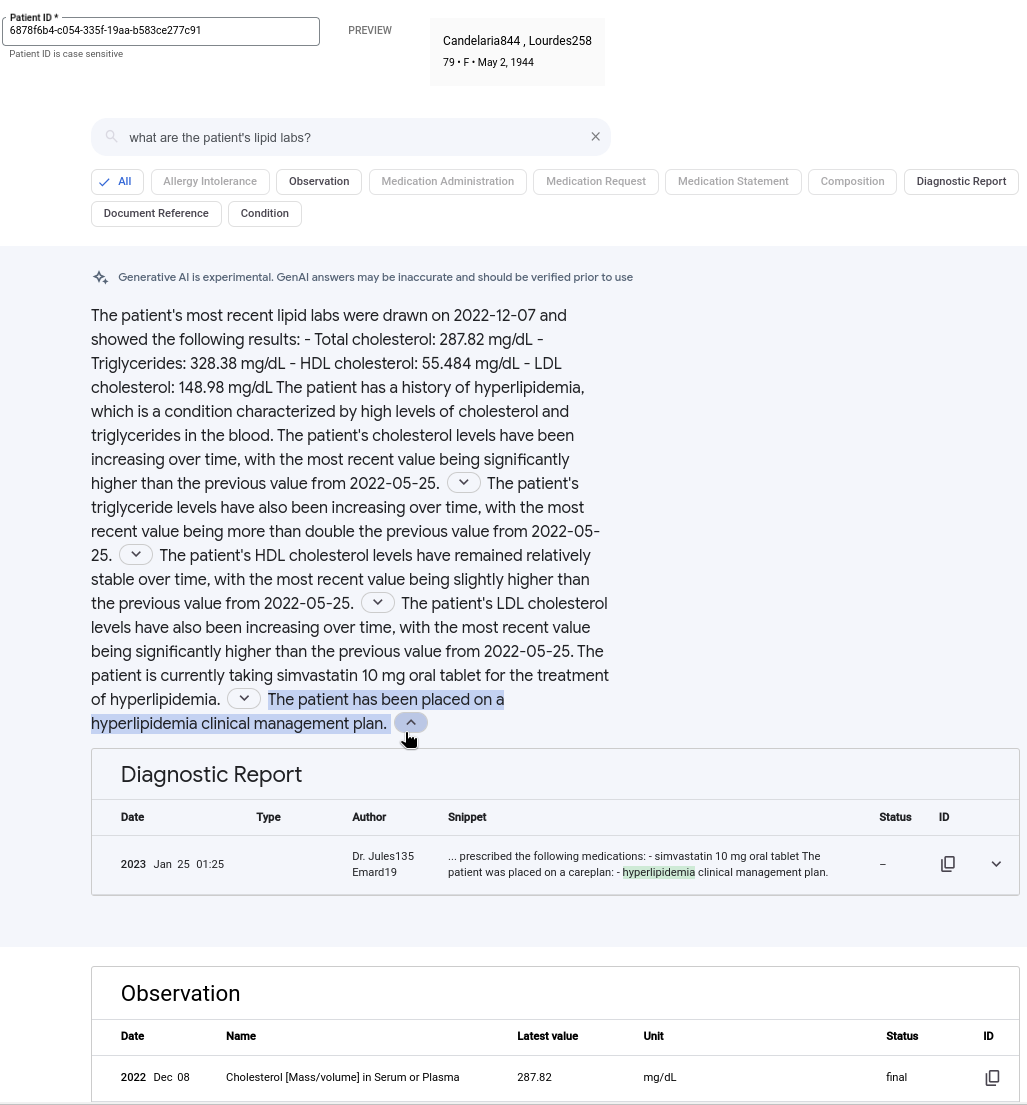After importing FHIR R4 data into your healthcare search app, you can query the imported data to get relevant results. You can search using the following types of queries:
- Keyword query
- Natural language query
- Natural language query with a generative AI answer
Additionally, you can filter your search using date-filtered queries. For
more information, see
Define a resource_datetime filter.
When you search in the Google Cloud console, you must first provide a patient ID and search over a single patient's data at a time. When you search using the REST API, you can search over your entire data store.
This page shows how to search healthcare data using the various types of queries.
Intended use of Vertex AI Search for searching healthcare data
The intended usage of Vertex AI Search is not to provide information pertaining to the prevention, diagnosis, or treatment of illness or disease. Questions regarding diagnosis or treatment recommendations are not intended to be addressed by the product. The intended use of this product is to retrieve and summarize existing medical information provided by users.
Due to limited test data, this product may or may not be applicable to age groups 0-18, and 85 and above. Therefore, when reviewing the generated output, customers must consider the representativeness of subpopulations within their source data.
The following are a few examples of how this product is intended to be used:
Exploratory queries to find a patient's information relevant to a topic:
- "Summarize the aspirin uses"
- "blood pressure"
- "diabetes management?"
Navigational queries to find specific resources that could be mapped to a structured query:
- "Show me the most recent a1c"
Extractive questions and answers to answer specific questions where evidence may be spread across resources:
- "Has this patient ever been treated with a cephalsporin"
- "Has the patient ever undergone psychiatry evaluation"
The following are examples of how this product is not intended to be used:
Diagnosis recommendations and treatment recommendations:
- "What is the differential diagnosis for this patient?"
- "What drugs should I prescribe to the patient?"
Query guidelines
The following guidelines can help you frame a query that can give you better search results:
Search for queries with specific intent: Because the model doesn't know what you're looking for, it's better to provide a targeted query than a vague one. For example, searching for the keyword "hypertension" is better than searching for the keyword "summary". While the query "hypertension" brings up specific results from relevant documents, the query "summary" can bring up results from documents that aren't relevant.
Preserve context: Because search isn't conversational, it's better to provide the full context for each query. For example, if your initial query is "hypertension" and you want to follow up on the same topic, then "when was hypertension diagnosed" is a better second query than "when was it diagnosed".
Simplify the query: Whenever possible, break down complex queries into simpler ones. For example, instead of searching for "creatinine and albumin", create different queries for "creatinine", "albumin", and "creatinine albumin ratio", depending on your objective.
Avoid asking for inferences: Search provides more precise results when the model can return information verbatim from the documents that it searches from instead of calculating or deducing from the searched information. For example, instead of querying "how much has the patient weight changed", you can query, "list the patient weight in the last 10 visits" and then calculate the weight change separately.
Match highlighting in results
Match highlighting is a configuration that highlights parts of text in a search result that contextually match the search query.
The results from the following resource types support match highlighting:
- Composition: Highlights contextual text from the
Composition.section[].text.divfield. - DiagnosticReport: Highlights contextual text from the
DiagnosticReport.conclusionfield. DocumentReference: Highlights contextual text from the documents referred in the
DocumentReference.content[0].attachment.urlfield. The highlighted text is encased within a bounding box. The bounding box is represented by two sets of normalized coordinates in the search response. The documents that support match highlighting are PDF files and image files with supported types. The following image shows how text is highlighted in a scanned document from the DocumentReference resource type:
Figure 1. Match highlighting in a DocumentReference scanned document.
When you search using REST API, you must enable match highlighting in your
search request using the
matchHighlightingCondition field.
The response contains the match_highlighting field, which you can use to
render the highlighted text in your search application:
- For Composition and DiagnosticReport documents, the
match_highlightingfield contains the start and end indexes for the token that must be highlighted. - For DocumentReference documents, the
match_highlightingfield contains the coordinates of the bounding box that highlights the text. The bounding box is represented by two sets of normalized coordinates with their origin at the top-left corner of the document. This field also nests thepage_numberfield, which is set to0for images and1for the first page of PDF files.
When you preview the search results using the Google Cloud console, match highlighting is enabled by default.
Before you begin
Before you search, do the following:
- Create a healthcare search app and a healthcare search data store, and import FHIR R4 data. For more information, see Create a healthcare search app and Create a healthcare search data store.
- Configure search results for healthcare data.
- To get helpful query suggestions when searching, turn on autocomplete. This is a Preview feature.
- Review the list of FHIR R4 resources that Vertex AI Search supports. For more information, see Healthcare FHIR R4 data schema reference.
Search using a keyword
You can search your healthcare data store using a keyword. For example, you can search using keywords such as "a1c", "insulin", or "ulcer" to get relevant FHIR resources.
The following image shows the search results when the keyword is "lipid". This example doesn't include a summary or generative AI answer.

To search using a keyword, complete the following steps.
Console
In the Google Cloud console, go to the AI Applications page.
Select the healthcare search app that you want to query.
In the navigation menu, click Preview.
In the Patient ID field, enter the ID of the patient whose data you want to query. Patient IDs are case-sensitive.
Press Enter or click Preview to submit the patient ID.
In the Search here search bar, type a keyword to search.
If you enabled autocomplete, you see a list of autocomplete suggestions below the search bar as you type.
Press Enter to submit the query.
- The search results are displayed in paginated tables that are categorized based on their FHIR resource type.
- By default, the search results for all FHIR resource types are displayed in reverse chronological order.
Optional. To filter the results, select one or more FHIR resource categories that are under the search bar.
Optional. To order results according to relevance for the Composition, the DocumentReference, and the DiagnosticReport resources, click the Sort: Reverse Chronological filter and from the list select Relevance. For more information, see Order healthcare search results.
REST
The following sample shows how to search a single patient's FHIR R4 data in the
healthcare search app using a keyword. This sample uses the
servingConfigs.search method.
By default, the search results are returned in a reverse chronological order. When you search over the Composition, the DiagnosticReport, and the DocumentReference resources, you can order your search results according to relevance. For more information, see Order healthcare search results.
Search using a keyword.
curl -X POST -H "Authorization: Bearer $(gcloud auth print-access-token)" \ -H "Content-Type: application/json" \ "https://us-discoveryengine.googleapis.com/v1alpha/projects/PROJECT_ID/locations/us/collections/default_collection/engines/APP_ID/servingConfigs/default_search:search" \ -d '{ "query": "KEYWORD_QUERY", "filter": "patientId: ANY(\"PATIENT_ID\")", "contentSearchSpec":{"snippetSpec":{"returnSnippet":true}} "displaySpec": { "matchHighlightingCondition": "MATCH_HIGHLIGHTING_CONDITION" } }'Replace the following:
PROJECT_ID: the ID of your Google Cloud project.APP_ID: the ID of the Vertex AI Search app that you want to query.KEYWORD_QUERY: the keyword that you want to search across the patient clinical data for the filtered patient, such as "diabetes" or "a1c".PATIENT_ID: the resource ID of the patient whose data you want to search.MATCH_HIGHLIGHTING_CONDITION: a string that can have the following values:MATCH_HIGHLIGHTING_DISABLED: turns off match highlighting on all documents.MATCH_HIGHLIGHTING_ENABLED: turns on match highlighting on all documents. When you leave this field empty or don't specify it, match highlighting is set toMATCH_HIGHLIGHTING_DISABLEDand is turned off on all documents.
Search using natural language query
Using Vertex AI Search, you can get results for complex natural language queries. For example, the following image shows the results for the the natural language query: "Lab results related to diabetes".

To search using natural language query, complete the following steps.
Console
In the Google Cloud console, go to the AI Applications page.
Select the healthcare search app that you want to query.
In the navigation menu, click Preview.
In the Patient ID field, enter the patient ID of the patient whose data you want to query. Patient IDs are case-sensitive.
Press Enter or click Preview to submit the patient ID.
In the Search here search bar, enter a natural language query, such as "Lab results related to diabetes".
If you enabled autocomplete, you see a list of autocomplete suggestions below the search bar as you type.
Press Enter to submit the query.
- The search results are displayed in paginated tables that are categorized based on their FHIR resource type.
- By default, the search results for all FHIR resource types are displayed in a reverse chronological order.
Optional. Select one or more FHIR resource categories that are under the search bar to filter the results.
Optional. To order results according to relevance for the Composition, the DocumentReference, and the DiagnosticReport resources, click the Sort: Reverse Chronological filter and from the list select Relevance. For more information, see Order healthcare search results.
REST
The following sample shows how to search a single patient's FHIR R4 data in the healthcare search app
using a natural language query. This sample uses the
servingConfigs.search method. To search using a natural
language query, you must add the naturalLanguageQueryUnderstandingSpec
field to the request body.
By default, the search results are returned in a reverse chronological order. When you search over the Composition, the DiagnosticReport, and the DocumentReference resources, you can order your search results according to relevance. For more information, see Order healthcare search results.
Post a query in natural language.
curl -X POST -H "Authorization: Bearer $(gcloud auth print-access-token)" \ -H "Content-Type: application/json" \ "https://us-discoveryengine.googleapis.com/v1alpha/projects/PROJECT_ID/locations/us/collections/default_collection/engines/APP_ID/servingConfigs/default_search:search" \ -d '{ "query": "NATURAL_LANGUAGE_QUERY", "filter": "patientId: ANY(\"PATIENT_ID\")", "contentSearchSpec":{"snippetSpec":{"returnSnippet":true}}, "naturalLanguageQueryUnderstandingSpec":{"filterExtractionCondition":"ENABLED"}, "displaySpec": { "matchHighlightingCondition": "MATCH_HIGHLIGHTING_CONDITION" } }'Replace the following:
PROJECT_ID: the ID of your Google Cloud project.APP_ID: the ID of the Vertex AI Search app that you want to query.NATURAL_LANGUAGE_QUERY: the query in natural language, such as "Lab results related to diabetes" or "Is the patient currently on any medication".PATIENT_ID: the resource ID of the patient whose data you want to search.MATCH_HIGHLIGHTING_CONDITION: a string that can have the following values:MATCH_HIGHLIGHTING_DISABLED: turns off match highlighting on all documents.MATCH_HIGHLIGHTING_ENABLED: turns on match highlighting on all documents. When you leave this field empty or don't specify it, match highlighting is set toMATCH_HIGHLIGHTING_DISABLEDand is turned off on all documents.
Search using natural language query with generative AI answer
When you search a patient's FHIR data using a natural language query, you can choose to get a generative AI answer along with the search results. The answer summarizes the search results and also shows the references that are used to generate the answer.
When using the console, you can select the large language model (LLM) for generative AI answers. For more information, see Configure search results for healthcare data.
When using the REST API, you can specify one of the following LLM models to give
you generative AI answers in the version field:
gemini-1.5-flash-001/answer_gen/v1orstable: a stable, generally available model that's based on thegemini-1.5-flash-001model. For more information, see Generally available (GA) models.gemini-1.5-pro-002orpreview: a preview model that's based on thegemini-1.5-promodel.
The following image shows an example of a natural language query with generative AI answer. The search summary provides an answer for the query by summarizing the findings from relevant results. You can expand segments that have citations to see the references that are used to generate the selected segment. Not all generated answers have citations.

To search with generative AI answer, do the following:
Console
In the Google Cloud console, go to the AI Applications page.
Select the healthcare search app that you want to query.
In the navigation menu, click Configurations.
Customize the search widget:
- In the Search type field, select Search with an answer.
- Select the model that you want to use to generate the summary. For more information, see Configure search results for healthcare data
- Save and publish your preferences.
In the navigation menu, click Preview.
In the Patient ID field, enter the patient ID of the patient whose data you want to query. Patient IDs are case-sensitive.
Press Enter or click Preview to submit the patient ID.
In the Search here search bar, enter a natural language query, such as "nsaids", "What are the patient's lipid labs", or "What is the most recent A1C result".
If you enabled autocomplete, you see a list of autocomplete suggestions below the search bar as you type.
Press Enter to submit the query.
- The generative AI answer is displayed under the search bar.
- The search results are displayed in paginated tables that are categorized based on their FHIR resource type.
- By default, the search results for all FHIR resource types are displayed in a reverse chronological order.
Optional. Expand a segment of the answer that has citations to see its references from the search results.
Optional. Select one or more FHIR resource categories that are under the search bar to filter the results.
Optional. To order results according to relevance for the Composition, the DocumentReference, and the DiagnosticReport resources, click the Sort: Reverse Chronological filter and from the list select Relevance. For more information, see Order healthcare search results.
REST
The following sample shows how to search a single patient's FHIR R4 data in the
healthcare search app using a natural language query with generative AI answers.
This sample uses the servingConfigs.search method.
- To search using a natural language query, you must add the
naturalLanguageQueryUnderstandingSpecfield to the request body. - To include inline citation indexes, you must add the
includeCitationsfield. This is a boolean field with default set tofalse.
By default, the search results are returned in a reverse chronological order. When you search over the Composition, the DiagnosticReport, and the DocumentReference resources, you can order your search results according to relevance. For more information, see Order healthcare search results.
Post a query in natural language.
curl -X POST -H "Authorization: Bearer $(gcloud auth print-access-token)" \ -H "Content-Type: application/json" \ "https://us-discoveryengine.googleapis.com/v1alpha/projects/PROJECT_ID/locations/us/collections/default_collection/engines/APP_ID/servingConfigs/default_search:search" \ -d '{ "query": "QUERY", "filter": "patientId: ANY(\"PATIENT_ID\")", "contentSearchSpec": { "snippetSpec": { "returnSnippet": true }, "displaySpec": { "matchHighlightingCondition": "MATCH_HIGHLIGHTING_CONDITION" } "summarySpec": { "summaryResultCount": 1, "includeCitations": true, "modelSpec": { "version": "MODEL_VERSION" } } }, "naturalLanguageQueryUnderstandingSpec": { "filterExtractionCondition": "ENABLED" } }'Replace the following:
PROJECT_ID: the ID of your Google Cloud project.APP_ID: the ID of the Vertex AI Search app that you want to query.QUERY: the query in natural language, such as "nsaids", "What are the patients lipid labs", or "What is the most recent A1C result". If the query includes an apostrophe', you must replace it with apostrophe's numeric character reference:'.PATIENT_ID: the resource ID of the patient whose data you want to search.MODEL_VERSION: the model version that you want to use to generate the answer.MATCH_HIGHLIGHTING_CONDITION: a string that can have the following values:MATCH_HIGHLIGHTING_DISABLED: turns off match highlighting on all documents.MATCH_HIGHLIGHTING_ENABLED: turns on match highlighting on all documents. When you leave this field empty or don't specify it, match highlighting is set toMATCH_HIGHLIGHTING_DISABLEDand is turned off on all documents.
